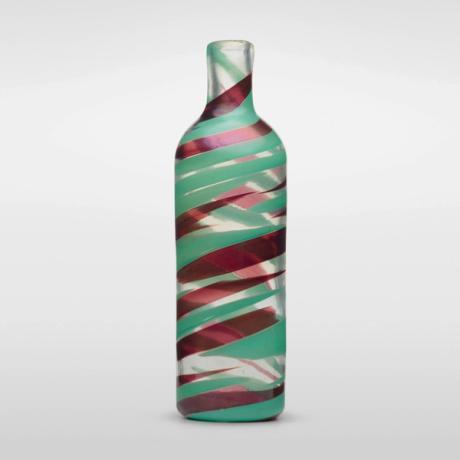Donation Vases
2019 - Sculpture (Sculpture)
103 x 54 x 14 cm, 107 x 54 x 12 cm, 108 x 54 x 11 cm
Ana Navas
Ana Navas uses humor to address formal, aesthetic, and societal conventions that are interwoven in the everyday through the normalization of gendered behaviors and style choices used to project personal and collective signifiers. In her Donation Vases she uses quotes taken from corporate coach Lois P. Frankel’s book Nice girls (still) don’t get the corner office: Unconscious Mistakes Women Make That Sabotage Their Careers (2004). The aspirational, somewhat cynical tone of the sentences – “When given a choice, sit next to most powerful person, their power will cascade over you,” “Why is it that women buy those little chains to hang reading glasses around their necks,” “If you see your reflection on a glossy surface & notice something wrong, avoid fixing it there” – reveals a particular understanding of what a professional, ambitious cis woman should look like, the persona she should project, and the type of desirable behaviors that constitute a stereotypical “successful woman” according to a capitalist morality. As a way to deconstruct these stereotypes, Navas offers this advice as “tips”- playing with the double sense of the word as counsel and gratuity – written on vases that resemble tourist souvenirs which would typically contain more naive rhetorics. The vases contain the tips “donated” by Frankel, effecting a displacement of the normalized, “universal” context they stem from and of the medium that carries them. The oscillations between the universal/modern and the local, high art and popular craft are embedded in these objects that are completed by the drawings made with steel wire illustrating a material aspect of the sentences. They appropriate a modernist, succinct aesthetics in contrast with the handmade character of the ceramic pieces. This contamination of styles is a kind of postmodernist collage that reflects on gender and its multiple, subtle ramifications.
Ana Navas’s practice deals with the vulgarization of modern art, understanding the term vulgar in its original sense of being appropriated by common people. She is interested in questioning the boundaries between low and high art and demonstrating how a modernist aesthetic language has permeated our daily lives in different ways. Her work takes the form of sculptures, paintings and videos made by using everyday objects and artisanal processes and deploying an acute sense of humor. She is interested in the contamination of forms, materials and references, materializing these inquiries into hybrid artworks. By embracing a DIY approach to artmaking which results in rather kitsch objects, she reclaims a space for production which has traditionally been used to disqualify the work of women artists.
Colors:
Related works sharing similar palette
» see more

© » KADIST
Leslie Shows
Human Quarry is a large work on paper by Leslie Shows made of a combination of acrylic paint and collage...

© » KADIST
Mark Bradford
2012This untitled work from 2012 is a print originally made as part of the Wattis Institute for Contemporary Art’s artist limited edition series...
Related works found in the same semantic group
» see more

© » THEARTNEWSPER
$4 thrift-store vase sells for $107,100 at auction Art market Museums & heritage Exhibitions Books Podcasts Columns Technology Adventures with Van Gogh Search Search Art market news $4 thrift-store vase sells for $107,100 at auction It turns out the glass vessel is a rare example of a 1940s Venini piece designed by the architect Carlo Scarpa Theo Belci 14 December 2023 Share Venini vase designed by Carlo Scarpa (around 1947) Courtesy Wright Auction House An Italian glass vase, purchased for $4 at a thrift store in Richmond, Virginia, fetched $107,100 (including buyer’s fee) on 13 December at Wright Auction House...

© » KADIST
Jumana Manna
2015Blue Elbow (Coude bleu) is made from plaster, burlap, lacquer, pigments and plastics...

© » KADIST
Martin Kippenberger
1989Untitled is a work on paper by Martin Kippenberger comprised of several seemingly disparate elements: cut-out images of a group of dancers, a japanese ceramic vase, and a pair of legs, are all combined with gestural, hand-drawn traces and additional elements such as a candy wrapper from a hotel in Monte Carlo and a statistical form from a federal government office in Wiesbaden, Germany...



